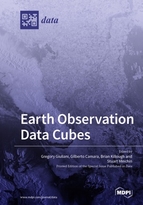Earth Observation Data Cubes
A special issue of Data (ISSN 2306-5729). This special issue belongs to the section "Spatial Data Science and Digital Earth".
Deadline for manuscript submissions: closed (15 June 2019) | Viewed by 111359
Special Issue Editors
Interests: earth observations; data cube; sustainable development; GEO/GEOSS; environmental sciences
Special Issues, Collections and Topics in MDPI journals
Interests: earth observation; land change monitoring; open source software
Special Issues, Collections and Topics in MDPI journals
Interests: satellite earth observations; data cubes; systems engineering
Special Issue Information
Dear colleagues,
Remotely sensed Earth Observations (EO) data have already exceeded the petabyte-scale and are increasingly freely and openly available from different data holdings. This poses a certain number of issues in terms of volume (e.g., data volumes have increased 10x in the last 5 years); velocity (e.g., Sentinel-2 is capturing a new image of any given place every 5 days); and variety (e.g., different types of sensors, spatial/spectral resolutions). Traditional approaches to the acquisition, management, distribution and analysis of EO data have limitations (e.g., data size, heterogeneity and complexity) that impede their true information potential to be realized.
The fact that the full information potential of EO data has not yet been realized and therefore remains still underutilized is explained by various reasons: (1) It requires scientific knowledge to understand what data is needed… optical (which resolution?), radar (which type?); (2) It is difficult to access and download the increasing volumes of data generated by satellites; (3) there is a lack of expertise and computing resources to efficiently prepare and utilize EO data; (4) the particular structure of EO data; and (5) the significant effort and cost required to store and process data limit its effective use.
Addressing Big Data challenges such as volume, velocity and variety, requires a change of paradigm and moving away from traditional local processing and data distribution methods to lower the barriers caused by data size and related complications in data management. In particular, data volume and velocity will continue to grow as the demands increase for decision-support information derived from these data.
To tackle these issues and bridge the gap between users’ expectations and current Big Data analytical capabilities, EO Data Cubes (EODC) are a new paradigm revolutionizing the way users can interact with EO data and a promising solution to store, organize, manage and analyze EO data. The main objective of EODC is to facilitate EO data usage by addressing volume, velocity, variety challenges and providing access to large spatio-temporal data in an analysis ready format.
Different EODC implementations are currently operational such as Digital Earth Australia, the Swiss Data Cube, the EarthServer, the E-sensing platform or the Google Earth Engine. These initiatives are paving the way to broaden the use of EO data to larger communities of users; support decision-makers with timely and actionable information converted into meaningful geophysical variables; and ultimately are unlocking the information power of EO data.
This Special Issue is consequently aiming to cover the most recent advances in EODC developments and implementations and welcomes contributions with respect to (but without being restricted to):
- Methods for generating Analysis Ready Data for both optical and SAR imagery
- Interoperability challenges between EO Data Cubes
- Algorithms for generating decision-ready products
- Data fusion techniques in EO Data Cubes
- Data mining using Machine Learning, Deep Learning, …
- Data quality, reliability, …
- Cost/Benefits analysis of EO Data Cubes
- Thematic applications (e.g. biodiversity, climate, health, natural hazards, …) using EO Data Cubes
- New innovative tools and solutions to work with EO Data Cubes
- Use of high to very-high resolution EO data
- Integration of in-situ observations
- Local, national, regional implementations
- Cloud-based computing
- Architecture design of EO Data Cubes (HPC, Distributed Computing, Super Computers)
- Capacity building and training
- Support to policy framework such as the Sustainable Development Goals, the Paris agreement, Aichi targets, or Water Framework Directive
- Links with initiatives like Copernicus or the Global Earth Observation System of Systems (GEOSS).
Dr. Gregory Giuliani
Dr. Brian Killough
Dr. Stuart Minchin
Prof. Dr. Gilberto Camara
Guest Editors
Manuscript Submission Information
Manuscripts should be submitted online at www.mdpi.com by registering and logging in to this website. Once you are registered, click here to go to the submission form. Manuscripts can be submitted until the deadline. All submissions that pass pre-check are peer-reviewed. Accepted papers will be published continuously in the journal (as soon as accepted) and will be listed together on the special issue website. Research articles, review articles as well as short communications are invited. For planned papers, a title and short abstract (about 100 words) can be sent to the Editorial Office for announcement on this website.
Submitted manuscripts should not have been published previously, nor be under consideration for publication elsewhere (except conference proceedings papers). All manuscripts are thoroughly refereed through a single-blind peer-review process. A guide for authors and other relevant information for submission of manuscripts is available on the Instructions for Authors page. Data is an international peer-reviewed open access monthly journal published by MDPI.
Please visit the Instructions for Authors page before submitting a manuscript. The Article Processing Charge (APC) for publication in this open access journal is 1600 CHF (Swiss Francs). Submitted papers should be well formatted and use good English. Authors may use MDPI's English editing service prior to publication or during author revisions.
Important dates
• September 1, 2018: Launch of the Call for Papers
• December 31, 2018: Deadline for abstract submission (800-word) to guest editors
• January 15, 2019: Notification of abstract acceptance and full paper submission invitation
• May 30, 2019: Deadline for submission
• June 30, 2019: Revision/rejection notification
• October 31, 2019: Paper acceptance notification
Keywords
- Earth Observations
- Data Cube
- Landsat
- Sentinel-1
- Sentinel-2
- Sustainable Development Goals
- Interoperability
- High-Resolution Data
- In-Situ Data Integration
- User-Driven Applications








